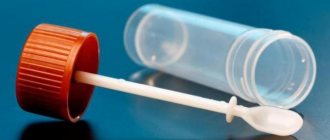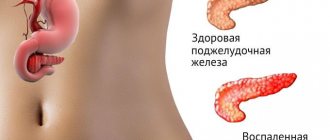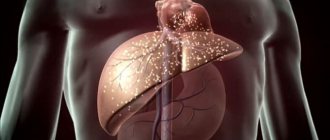General information
The enzyme is a component of pancreatic juice and is responsible for the breakdown of carbohydrates. The concentration of the enzyme in the blood is normally low. Pancreatic juice enters the duodenum and is involved in the process of food digestion. The presence of the enzyme in the blood is normally explained by the renewal of the cells in which it is contained. The release of amylase into the blood in large quantities is most often caused by a blockage of the pancreatic duct (for example, a tumor or stones) or significant damage to the pancreas.
This test is of high importance in the diagnosis of pancreatitis
and a number of other diseases in which the pancreas is involved in the pathological process. It is often prescribed in conjunction with a blood test for lipase (an enzyme that is responsible for the breakdown of fats). Also, the test results are used to monitor the condition of patients with cancer that affects the pancreas; assessing the results of surgical intervention.
Pancreatic amylase
Pancreatic amylase is one of the types of amylase that is produced by the pancreas.
Synonyms Russian
P-amylase isoenzyme, pancreatic alpha-amylase, P-amylase, P-type amylase.
English synonyms
Pancreatic alpha-amylase, pancreatic AML, P-type amylase, P-type alpha-amylase, amylase isoenzymes, amylase isoforms.
Research method
Enzymatic colorimetric method.
Units
U/L (unit per liter).
What biomaterial can be used for research?
Venous blood.
How to properly prepare for research?
- Do not eat for 12 hours before the test.
- Avoid physical and emotional stress and do not smoke for 30 minutes before the test.
General information about the study
Amylase is a digestive enzyme that can break down carbohydrates.
The largest amount of amylase is found in the salivary and pancreas glands.
Amylase, which is produced in the pancreas, is pancreatic amylase (P-type) and is part of pancreatic juice. From the pancreas, pancreatic juice containing lipase passes through the pancreatic duct into the duodenum, where it helps digest food.
Amylase of the salivary glands - salivary amylase (S-type) - digests food starch in the oral cavity.
Normally, a small amount of amylase circulates in the blood. In this case, about 60% is salivary amylase (S-type), and the remaining 40% is pancreatic amylase.
When damage to the pancreas occurs, as in pancreatitis, or if the pancreatic duct is blocked by a stone or tumor, pancreatic amylase (P-type) begins to leak into the bloodstream in large quantities. There is no increase in salivary amylase activity.
Small amounts of amylase are also produced in the ovaries, intestines and skeletal muscles.
What is the research used for?
- An increase in the activity of pancreatic amylase in the blood without a change in the activity of salivary amylase confirms the pathology of the pancreas. For example, in acute pancreatitis, its activity in the blood can increase to 90% of the total amylase activity.
- For the diagnosis of pancreatitis in the postoperative period, when the activity of total amylase is increased.
- If pathology of the salivary glands, ovaries or bronchi is suspected.
When is the study scheduled?
- When the diagnosis of “acute” or “chronic pancreatitis” is confirmed.
- If you suspect a disease of the salivary glands and ovaries.
What do the results mean?
Reference values
| Age | Reference values |
| < 1 year | < 8 U/l |
| 1 – 10 years | < 31 U/l |
| 10 – 18 years | < 39 U/l |
| > 18 years old | < 53 U/l |
Interpretation of the results of the analysis for pancreatic amylase is carried out taking into account the assessment of the total amylase activity in the blood or urine. If the total amylase activity is increased and the activity of pancreatic amylase is decreased, then damage to the pancreas is unlikely and pathology of the ovaries, intestines, bronchi or other organs must be excluded.
Reasons for increased pancreatic amylase activity
- Acute pancreatitis. In this disease, the activity of pancreatic amylase can be significantly higher than normal and constitute a larger percentage of the activity of total amylase. However, in some patients with acute pancreatitis, amylase may increase slightly or even remain normal. In general, amylase activity does not reflect the severity of pancreatic damage in pancreatitis. For example, with massive pancreatitis, sometimes the death of most of the cells that produce this enzyme occurs, so its activity may not be changed.
- Chronic pancreatitis. With it, amylase activity is initially moderately increased, but then may decrease and return to normal as damage to the pancreas worsens.
- Decompensation of diabetes mellitus is diabetic ketoacidosis, both due to high sugar levels and due to the concomitant involvement of the pancreas in the pathological process.
- Trauma to the pancreas.
- Pancreas cancer.
- Blockage (stone, scar) of the pancreatic duct.
- Acute appendicitis, peritonitis.
- Perforation (perforation) of a stomach ulcer.
- Acute cholecystitis is inflammation of the gallbladder.
- Intestinal obstruction.
- Ruptured aortic aneurysm.
- Macroamylasemia is a condition where amylase binds to large proteins in the serum and therefore cannot pass through the glomeruli, accumulating in the blood.
Reasons for decreased pancreatic amylase activity
- Decreased pancreatic function.
- Cystic fibrosis (cystic fibrosis) of the pancreas is a severe hereditary disease associated with damage to the exocrine glands (lungs, gastrointestinal tract).
- Removal of the pancreas.
What can influence the result?
- Captopril, corticosteroids, oral contraceptives, furosemide, ibuprofen, and narcotic analgesics can increase amylase activity.
- Chronic renal failure sometimes leads to increased activity of pancreatic amylase.
- Elevated cholesterol can cause decreased activity of pancreatic amylase.
Important Notes
- In acute pancreatitis, an increase in pancreatic amylase activity is usually accompanied by an increase in lipase activity. The latter may be somewhat delayed, but lipase activity remains elevated longer.
- Amylase activity in children in the first two months of life is low; it rises to adult levels by the end of the first year.
Also recommended
- Total amylase in daily urine
- Serum total amylase
- Lipase
Who orders the study?
General practitioner, therapist, gastroenterologist, surgeon.
Decoding the results
The norm of total amylase is 28-100 U/l. The pancreatic enzyme concentration is interpreted in relation to the total amount of amylase. The most common cause of elevated readings is pancreatitis. In acute illness, values can exceed the norm by 6-10 or more times. It remains high for 3-5 days. If the readings are several times higher than normal, the pain is most likely caused by damage to the pancreas. It must be taken into account that in some patients with acute pancreatitis, enzyme activity remains within normal limits or increases slightly. The severity of the disease cannot be judged from the results of this test. For example, if most of the cells that produce the enzyme die, its activity remains within normal limits. With a chronic disease, the indicators first increase and then gradually decrease. Most often, chronic disease develops in alcoholics. An increase in the amount of the enzyme can be explained by other reasons (for example, pancreatic malignancy, peritonitis, pregnancy).
A decrease in the amount of the enzyme is observed in patients with high cholesterol, severe hepatitis, decreased pancreatic functionality, and cystic fibrosis. To obtain an interpretation of the results and further recommendations, you should consult a doctor. In many cases, if indicators are violated, the patient requires immediate medical attention. Self-medication is unacceptable, as it can cause irreversible pathological changes in the body.
Blood diastasis (amylase)
Diastase (alpha-amylase) refers to hydrolytic enzymes produced by the pancreas and included in pancreatic juice. It takes part in the breakdown of carbohydrates (under its influence, starch and glycogen are decomposed to maltose). In addition to the pancreas, the enzyme is secreted by the salivary glands. It is produced in much smaller quantities by the ovaries, intestines, liver, and fallopian tubes.
Blood serum contains two isotypes of amylase - salivary and pancreatic. If a person is healthy, the content of these enzymes in the blood is almost equal. Amylase activity is not affected by food intake, its level does not change during the day.
Once in the oral cavity (salivary) or duodenum (pancreatic), amylase helps digest carbohydrates from food. The concentration of amylase in the blood of a healthy person is insignificant (its presence is determined by the renewal of cells of the salivary glands and pancreas). The enzyme is excreted through the kidneys, therefore, with an increase in the level of amylase in the serum, its amount also increases in the urine. One of the reasons for an increase in the level of the enzyme in the blood and then in the urine may be blockage of the pancreatic duct with a stone or tumor. The ability of amylase to form massive compounds with immunoglobulins and other plasma proteins can lead to an increase in the level of the enzyme in the blood. At the same time, its content in the urine remains normal, because due to its size, the formed complexes do not pass through the kidney filter and do not leave the body.
The study of amylase levels in blood serum is intended primarily for diagnosis and monitoring the effectiveness of treatment of pancreatitis (inflammation of the pancreas). In acute pancreatitis, the concentration of amylase increases 6-10 times. This occurs 2-12 hours after the pancreas is damaged. High enzyme levels can last for 3-5 days. If the amylase level is above 1000 U/l, then there is a high probability that the pain is caused by acute pancreatitis. At the same time, there are cases when in patients the indicator increased slightly or remained normal. Thus, amylase activity cannot reliably judge the severity of damage to the pancreas (for example, massive pancreatitis causes massive death of pancreatic cells that produce amylase, so a change in its level is not observed).
Acute pancreatitis is usually accompanied by an increase in lipase concentration (item 667 in the “Laboratory tests” section), therefore, quite often, when diagnosing this disease, in parallel with determining the amylase level, a lipase level test is prescribed.
In the chronic form of pancreatitis, amylase levels increase moderately with a tendency, as the pancreas is further damaged, to gradually decrease to normal values. In the vast majority of cases, chronic pancreatitis is observed in alcoholics.
It is recommended to study amylase levels if a combination of the following symptoms indicates damage to the pancreas:
- intense girdling pain (simultaneously in the back and abdomen);
- lack of appetite;
- vomiting;
- increase in body temperature.
In addition to diagnosing pancreatic diseases, this test is used to monitor the patient’s condition and evaluate the effectiveness of treatment.










